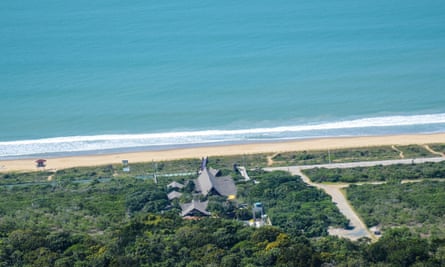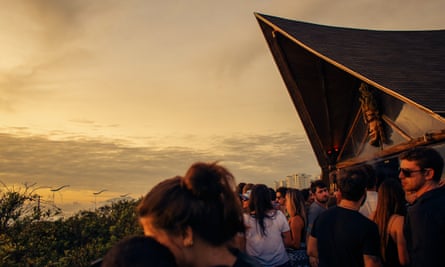No matter who is behind the decks come 7am, Warung Beach Club always has the same headline act. The main room of the 2,500-capacity temple to dance music on the Brazilian coast faces east towards the south Atlantic, which means God herself does the lighting. “When the sun comes up, it’s magical,” says club founder Gustavo Conti, standing on a terrace overlooking the beach. “That’s because nature is magical, and we’re here in it.”
The Guardian’s product and service reviews are independent and are in no way influenced by any advertiser or commercial initiative. We will earn a commission from the retailer if you buy something through an affiliate link. Learn more.
The club, in the southern state of Santa Catarina, emerges from the Atlantic forest where the land meets the sea, enclosed by vegetation on all sides and built from wood, like a particularly ambitious treehouse. Next month, Warung celebrates its 16th anniversary. DJ Lee Burridge has been coming to play here for almost that long. “It’s one of those endlessly wonderful places that you never want to leave,” he says. “Where it is and what it’s built from give the sound a really warm resonance. Inside you can be hit over the head with a shovel musically, and outside you can be cuddled musically. There’s also a lot of beautiful, beautiful people dancing their asses off.”

Those beautiful people make the pilgrimage from across Brazil, as well as from Buenos Aires and other foreign lands. The night I visit is a big one for Barbara Boeing, an Italo-disco DJ from nearby Curitiba who is playing Warung for the first time. She has been coming to the club since she was 18. “All my friends would get in the car together and drive for two and a half hours,” she remembers. “The first or second time I came was to see Richie Hawtin, who was my idol at the time. I used to play minimal techno, so when I saw him I felt as if I was seeing God.”
For the first 10 years, we never knew each month whether we’d be able to open the next month
In its early days, Warung shaped southern Brazil’s nascent electronic scene by bringing in international stars such as Dave Seaman, Sasha & Digweed, and Layo & Bushwacka! “We’d put on psytrance downstairs in the garden because that’s what the locals wanted to hear, then we’d lure them up to hear what Lee Burridge was doing in the main room,” says Conti. “The biggest contribution we could make was to educate people.”
Boeing explains how Warung has stayed relevant. “A lot of clubs tend to do the same thing over and over,” she says. “But Warung are still bringing in new styles of music. They’re the trendsetter for the region. Every Brazilian DJ wants to play here.”
Running the club hasn’t always been easy. Conti built it on a patch of land he purchased with the profits from selling his Curitiba club Rave. The isolated location, near where he had surfed as a teenager, was problematic. “We had all the challenges you can imagine,” he says. “I lost a lot of hair.” They had to bring in generators for electricity and dig a well for water. “The toilets have mineral water in them here, because that’s what we found.”

The club’s distinctive architecture was inspired by Conti’s surfing trips to Bali with his business partner João Guilherme Michelin Mansur. They would shelter from the sun under the overhanging roofs of Indonesian shacks known as warungs, Conti explains. “They live and work in warungs, which means ‘house’ – and we play house music, so [the name] made sense.”
Having overcome construction problems, the club was then faced with a string of legal issues. They consistently received noise complaints despite being some distance from the nearest residential area. An expert told Conti that when the wind came from a certain direction it would bounce off the hills, amplify the sound and blow it towards the apartment blocks. At one point, a local prosecutor ordered the club be demolished. Conti fought the decision in federal court, backed by the support of local hotels, restaurants and taxi drivers.

“For the first 10 years, we never knew each month whether we’d be able to open the next month,” says Conti. “When you start an electronic club you have to battle stigma, like rock’n’roll did in the past. The authorities look at you as if you’re a criminal. We had to fight to party.”
In 2012, they won the case and saved the club. Now they plan to go global, by opening a base in Barcelona to help more Brazilian DJs tour in Europe. But for Conti, there will never be anywhere quite like his place by the sea. “Sometimes you can’t believe the energy,” he says. “It really represents the devotion of all the people who come here for the music. It’s like a second home for them.”
On the Saturday night I visit, that energy crackles through electric sets by Burridge, Boeing and Spanish producer John Talabot until, sometime around 5.40am, light begins to filter into the long wooden hall of Warung’s main room. The dancing faithful turn to welcome the dawn.

Warung’s top five tracks
Layo & Bushwacka! – Love Story
“This was a hit at the club from the very beginning,” says Conti. “They’ve played here many times, and as soon as this track comes on you can feel the energy of the room being optimised.”
John Digweed – Warung Beach
“In 1996 I got Sasha and John Digweed’s album Northern Exposure. Those guys are the mother and father of the style of music we love. To have those guys come here and say it’s one of the best clubs in the world, and to have John Digweed make a track called Warung Beach … even now I can’t believe that happened.”
Oxia – Domino
“This is one of the most played tracks here. Many DJs from many countries have played it and every time it goes down well.”
Agoria – Scala
“A video on YouTube from last year shows Agoria playing this at sunrise. [The sun] was perfectly aligned with the building. It was an unforgettable sunrise. The music has that rising feeling too.”
Depeche Mode – Enjoy the Silence
“Many DJs here play Depeche Mode remixes. Sometimes I think that’s because they know we like them and they’re trying to make sure they get invited back! For me, Depeche Mode, along with New Order and Joy Division before them, are kind of the beginning. They’re one of the sources of this kind of music.”

Comments (…)
Sign in or create your Guardian account to join the discussion